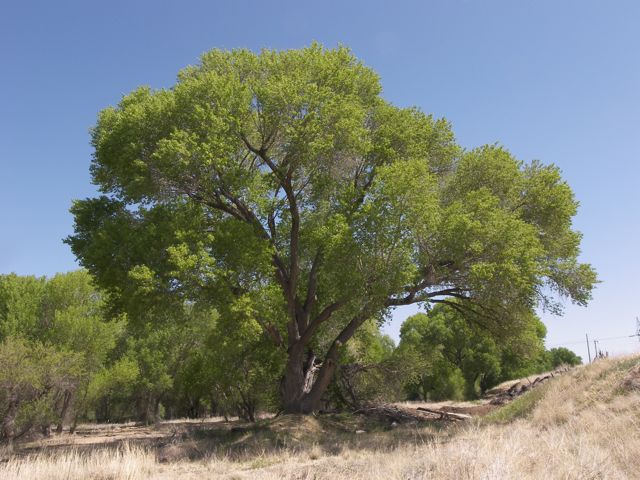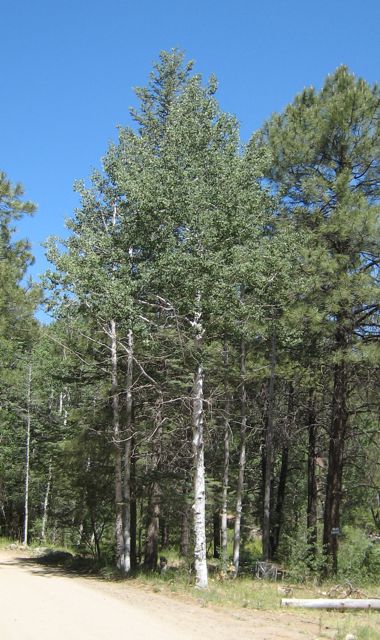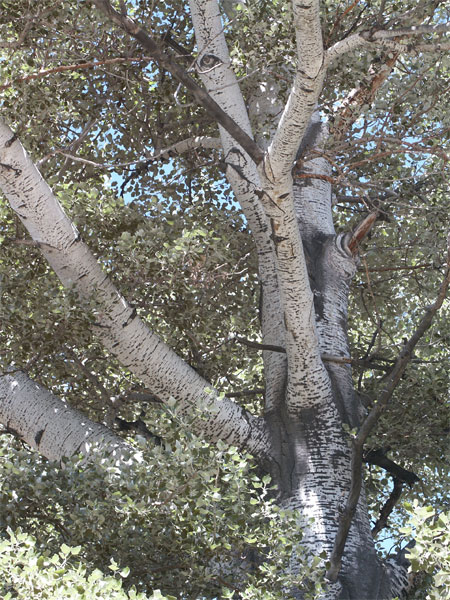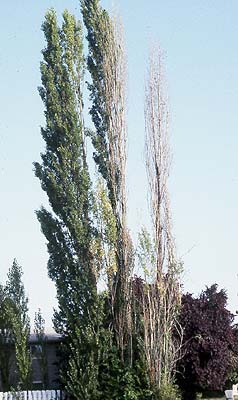 Cottonwood Trees - April 24, 2019 Jeff Schalau, Agent, Agriculture & Natural Resources University of Arizona Cooperative Extension, Yavapai County Yavapai County has two native species of cottonwood trees in addition to the native quaking aspen trees. The cottonwood trees are Fremont cottonwood (Populus fremontii) and narrowleaf cottonwood (P. angustifolia). These two trees also hybridize to produce Populus x hincleyana. Aspens (P. tremuloides) are also close relatives of cottonwood. Other cottonwoods species and hybrids have also been introduced to northern Arizona. The most common of these are the Lombardy poplar (P. nigra ‘Italica’) and white poplar (P. alba). None of these trees are suitable for most landscapes due to their high water use requirements. However, the native species are important components of riparian ecosystems and high elevation forests. Fremont cottonwoods can become very large when grown in or near a perennial water source. When young, they often perform well in irrigated landscapes. Over time, they usually outgrow the irrigation system and begin to die back or succumb to disease. I have rarely seen large planted cottonwoods that have survived longer than 12 or 15-years landscape unless they are adjacent to a creek, river, ditch or septic system that supplies large amounts of water. When regularly flood irrigated, they will grow and survive, but most home irrigation systems will not provide adequate irrigation for cottonwood trees. When they do survive and grow, cottonwoods often outgrow their allotted space in the landscape, produce large roots that invade leach fields or buckle sidewalks/foundations, and/or require excessive pruning to remove dead wood. Lombardy poplars were also once very common in the retail nursery trade but have fallen from favor in northern Arizona for various reasons – primarily, a lack of drought tolerance and disease susceptibility. These European natives exhibit a columnar or pyramidal growth form and were often used in hedgerows and windbreaks. They tend to persist by sprouting from previously established root systems. Narrowleaf cottonwoods are not commonly available for sale in nurseries, but there are many populations along the creeks in Prescott. These natives are tall and sparsely branched. Here, they are also short-lived, but are taller and skinnier than Fremont cottonwoods. Acorn woodpeckers love to nest in their dead trunks. I don’t mind this, but it is not common for people to want dead trees in their landscape (I’m just crazy I guess). Aspens are loved for their white bark, trembling leaves, and vivid yellow fall color. However, they should only be planted at higher elevations. They struggle a little in Prescott (at 5,500 ft. plus), but when planted at lower elevations, they perform marginally or poorly. Flagstaff is a better location for them, but there, natural stands are experiencing “aspen decline”. In the Flagstaff area, aspen decline has been a problem in native aspen stands following a June freeze in 1999, subsequent droughts in 2001-02, tent caterpillar damage after that, and constant grazing pressure from elk. Many aspen stands in the Flagstaff area have declined due to these factors. Cottonwoods, poplars, and aspens can also produce suckers from the root system. These suckers sprout from adventitious buds and have the ability to produce new trees if left alone. In irrigated landscapes, suckers are often undesirable and require additional maintenance. When removed, a wound is also left behind creating an entry point for disease organisms to establish themselves. Species of Populus are widely used in landscapes – especially when fast growth is desired. Most of these are hybrids and most often they are so-called “cottonless” cottonwoods. These are male clones selected because they do not produce the cottony seeds that become a nuisance. This is not to say they are a good choice for residential landscapes – they are not. I’ve mentioned the cottonwood’s susceptibility to diseases above. Some specific fungal diseases are sudden death from cotton or Texas root rot (Phymatotrichopsis omnivorum) and slower acting rot diseases caused by Cytpospora canker (Cytospora chrysosperma), Ganoderma root rot (Ganoderma lucidum), and Inonotus heart rot (Inonotus munzii). Cottonwoods are also very susceptible to true (leafy) mistletoe infections. So, you’ve read this far – do you get the idea that I don’t recommend cottonwood trees for residential landscapes? That’s right! I think they are great along the rivers and creeks where they are part of a native ecosystem, but, being native, they also have their own set of natural population control mechanisms that prevent them from thriving in planted landscapes. Willows are also close relatives of cottonwoods and are similarly short-lived in landscapes. See below for additional resources and photos. Follow the Backyard Gardener on Twitter – use the link on the BYG website. If you have other gardening questions, call the Master Gardener help line in the Camp Verde office at 928-554-8992 or e-mail us at verdevalleymg@gmail.com and be sure to include your name, address and phone number. Find past Backyard Gardener columns or provide feedback at the Backyard Gardener web site: http://cals.arizona.edu/yavapai/anr/hort/byg/. Photos  Fremont cottonwood tree (Populus fremontii, Sue Smith @ http://cals.arizona.edu/yavapaiplants).
Fremont cottonwood tree (Populus fremontii, Sue Smith @ http://cals.arizona.edu/yavapaiplants). Narrowleaf cottonwood tree (Populus angustifolia, Sue Smith @ http://cals.arizona.edu/yavapaiplants).
Narrowleaf cottonwood tree (Populus angustifolia, Sue Smith @ http://cals.arizona.edu/yavapaiplants). Quaking aspen (Populus tremuloides, Doug McMillan @ http://cals.arizona.edu/yavapaiplants).
Quaking aspen (Populus tremuloides, Doug McMillan @ http://cals.arizona.edu/yavapaiplants). White poplar (Populus alba, https://forestry.usu.edu/tree-identification/poplar-and-aspen).
White poplar (Populus alba, https://forestry.usu.edu/tree-identification/poplar-and-aspen). Lombardy poplar showing decline (Populus nigra 'Italica', https://oregonstate.edu/dept/ldplants/ponii.htm).
Lombardy poplar showing decline (Populus nigra 'Italica', https://oregonstate.edu/dept/ldplants/ponii.htm).Additional Resources Yavapai County Native and Naturalized Plants: Trees, University of Arizona Cooperative Extension cals.arizona.edu/yavapaiplants/Trees/trees.php Poplar and Aspen Trees, Utah State University Extension forestry.usu.edu/tree-identification/poplar-and-aspen Cottonwood and Poplar Disease, Texas A & M Agrilife Extension plantdiseasehandbook.tamu.edu/landscaping/trees/cottonwood-and-poplar/ |